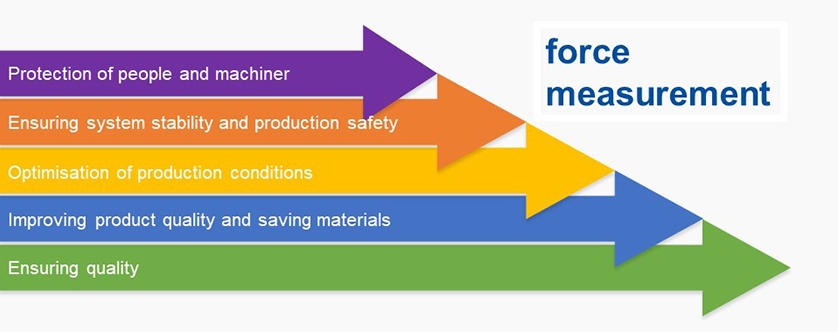
WIKA has been an internationally recognised partner for all measurement tasks for many decades. The product portfolio includes pressure, temperature, force and level measurement, as well as flow measurement, calibration and SF6 gas solutions. In the following article, we would like to take a closer look at the measured variable of force. These five reasons show why force measurement is of particular importance. 
Reason 1: Protection of people and machinery
Protecting people from harm is the highest priority in any workplace. Likewise, the machinery should remain undamaged in order to minimise downtime and repairs. In this context, force measurement ensures a safe working environment, especially through overload protection. In cranes, for example, this prevents heavy loads from falling. With construction machinery and robots, on the other hand, uncontrolled machine movements are prevented. This makes it possible to work safely, and completely harmlessly, next to and with machinery. In production lines, for example, the machinery is prevented from pulling, pushing or pressing unchecked, and thereby destroying both components and itself. Another example is port logistics, for which WIKA offers a globally unique, certified system.
- Added value: Safe working environment
Reason 2: Ensuring system stability and production safety
Just collecting data is not enough. The correct measured values are also required to be able to monitor processes seamlessly. Using force measurement in linear drives, for example, thus improves process control as well as automation, while simultaneously ensuring quality. Force measurement also provides the right data for the correct functioning of brakes and drives, conveyors, presses and weighing systems. A crucial point here is to reduce running costs. The higher the quality of the measured data, the better the data analysis. The planning of a tool change is thus more precise, so that changing it too early doesn’t cause increased costs nor does unplanned maintenance cause longer downtimes. The savings in consequential costs alone pay for it many times over.
- Added value: Full process control
Reason 3: Optimisation of production conditions
The savings potential, and thus the maximisation of profit, have already been mentioned in the previous section. Only through the optimal use of materials and machinery can margins be increased. A key issue in manufacturing plants is machine availability. In addition to reducing downtime, the focus is on minimising maintenance costs. A good example of this are welding tongs. With these, the contact force of the electrodes can be precisely monitored by using tension/compression force transducers. In this way, optimum quality is permanently guaranteed and, at the same time, wear is minimised. Higher profits can also be achieved through saving time, for example, when containers are weighed “on the fly”.
- Added value: Maximum profits
Reason 4: Improving product quality and saving materials
The use of force measurement in welding tongs – as explained in the section above – is a very good example of improving product quality as well as saving materials. Force measurement provides the right data for the most accurate process control. As a result, machine tool wear is only minimal. In addition, force measurement offers many other areas of application. For example, spreading fertiliser where this action is adapted to the soil conditions is one way to save material. This also protects the environment. Furthermore, it is advantageous to know the (supporting) forces acting on mobile cranes. The vehicle’s centre of gravity can thus be calculated exactly, which means that the safety margin can be reduced. In this case, loads can be lifted further, yet accidents, e.g. due to slipping or tipping, can be avoided.
- Added value: Lowering costs
Reason 5: Ensuring quality
Finally, the use of force measurement also offers many advantages in the area of quality assurance, which has already been touched upon. On the one hand, the machinery can be optimally controlled by registering the force. On the other hand, by recording the values, live as well as saving them for later use, conclusions can be drawn for specific batches. In addition, the most precise force measuring instruments meet the highest requirements, for example, in materials testing machinery or in medical engineering. Incidentally, WIKA also offers a DAkkS-accredited calibration service for force measuring instruments.
- Added value: Exact measured values
Note
Further details on our portfolio of force measuring instruments can be found on the WIKA website. There you will also find information on our calibration service for force measuring instruments. In addition, our brochure on force measurement: “Force measurement is a matter of trust” is also available. Would you like to buy force transducers? In our WIKA online shop you’ll find some of our standard versions. If you have any questions about force measurement, please ask your contact person.
Also read our articles
The ELMS1 overload protection saves lives
Force measurement in linear drives


la protection des personnes et des machines doit rester une priorité pour les entreprises comme on dit “prévenir que guérir”
et votre proposition est mise en amont pour améliorer la sécurité des personnes et des biens.
très bonne initiative. bon courage a vous .